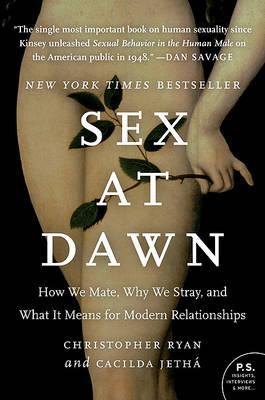
Book Review: Sex at Dawn – Christopher Ryan and Cacilda Jethá
Danielle Dorky reviews Sex at Dawn, and gives her thoughts on the controversial nonfiction book about the nature of human sexuality.
Author: Christopher Ryan and Cacilda Jetha
Book Title: Sex at Dawn: How We Mate, Why We Stray and What it Means for Modern Relationships
Genre: Nonfiction, Human Sexuality, Anthropology, History, Biology
Length: 416 pages paperback
Publish date: 2010
Publisher: Harper Perennial
Similar books/authors: The Ethical Slut by Dossie Easton, I Don’t: A Contrarian History of Marriage by Susan Squire
Re-readability: [Rating:7/10]
Dorkproval rating: [Rating:7.5/10]
Favorite Quote: “Now there you have a sample of man’s “reasoning powers,” as he calls them. He observes certain facts. For instance, that in all his life he never sees the day that he can satisfy one woman; also, that no woman ever sees the day that she can’t overwork, and defeat, and put out of commission any ten masculine plants that can be put to bed to her. He puts those strikingly suggestive and luminous facts together, and from them draws this astonishing conclusion: The Creator intended the woman to be restricted to one man. – Mark Twain “
Before I swore off talking to adults about sex, three all-important facts of life were bestowed upon me in no uncertain terms:
1) The purpose of sex is procreation, and procreation should not occur outside of marriage; thus, sex should not occur outside of marriage.
2) Sex is not really all that great anyway, trust us, you’re not missing much.
3) No man is going to buy the farm when he’s getting the milk for free.
This narrative continues to prevail in current society, and in upholding it, we tell ourselves we’re honoring the tradition of marriage, a lifelong monogamous tradition that comes as natural to our species as breathing oxygen. Still, 20,000 years of documented history begs to know: If we’re truly predisposed to lifelong pair bonding, why do half of marriages end in divorce and so many others exist only through a tacit agreement of discreet infidelity? In Sex at Dawn, Christopher Ryan and Cacilda Jetha answer these questions and take a look at the prehistoric origins of modern sexuality through a lens that is unobscured by religion or cultural bias.
What popular sex advice columnist Dan Savage calls “The single most important book on human sexuality since Kinsey unleashed Sexual Behavior in the Human Male on the American public in 1948,” does not read like your typical textbook. In addition to providing a thorough background on pre-agricultural human behavior and habits, and evidence showing the chronic Flinstonization of scientific data, Sex at Dawn is interjected with snarky asides poking fun at history’s more bizarre blunders. Though not entirely unbiased, Sex at Dawn does not explicitly promote or denounce any one tradition or belief, it’s primary suggestion is that we set aside both in the interest of gaining a more thorough understanding of our species.
A few thought-provoking theories found within the pages of Sex at Dawn include:
Procreation was never the sole purpose of sex, in fact, our preagriculture ancestors (and some close primate relatives) used sex to destress, smooth over disagreements, and of course, as a pleasurable pasttime.
There is a correlation between infrequent ejaculation and various health problems such as prostate cancer.
Women’s sexuality is much more contextual than men’s, which is how a morally rigid society contributes to the widespread belief that women are predisposed to a lackluster or conservative sex drive. Conversely, highly sexual women tend to be more fluid in their desires and gender preferences.
In addition to giving us insight into the mating and social behaviors of our pre-agricultural ancestors, Sex at Dawn also tells us their eating habits, average life spans and general quality of life. It turns out, living in an age of convenient interstates, complex societies, and new technology does not translate to living in the Golden Age of human existence. In many ways, those conveniences are a threat to the longevity of our species, and our continued denial of such only makes it that much more of a slippery slope to navigate.
Critics of Sex at Dawn argue that much of the evidence presented in the book is based on unfounded research and flimsy statistics, and although there is truth to that argument, I think more to blame is our general lack of investment in human sexuality. Let us not forget that Dr. Masters and Virginia Johnson were pioneers in the field, and the majority of their work is not even a half-century old. Let’s also note how controversial many of their findings that we now consider common knowledge were when first presented to their medical peers. Besides, Sex at Dawn is not suggesting that we revert to our pre-agricultural habits, only that we consider their implications in how human beings evolved to thrive in their surroundings.
Sex at Dawn advocates that humans have a deeper capacity for love, cooperation and generosity than we realize. Instead of accepting wanton sex lives, simmering resentment and chronic boredom, it dares us to question the standard narrative and create more fulfilling lives for ourselves by doing what our species was truly designed to do: adapt.
Categories: Reviews

